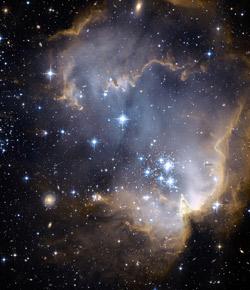Stars And Galaxies II

This quiz evaluates each student's level of comprehension following a lesson on stars and galaxies.
- 1.
This is a ___________.
- A.
Galaxy
- B.
Bright star
- C.
Rainbow
- D.
Universe
Correct Answer
A. GalaxyExplanation
A galaxy is a vast system of stars, gas, dust, and other celestial objects bound together by gravity. It is a collection of billions or even trillions of stars, along with planets, asteroids, and other cosmic bodies. Galaxies come in various shapes and sizes, and they can contain different types of stars and nebulae. They are fundamental building blocks of the universe and play a crucial role in the formation and evolution of celestial objects.Rate this question:
-
- 2.
A White Star is the hottest star.
- A.
True
- B.
False
Correct Answer
B. FalseExplanation
Blue starts are the hottest.Rate this question:
-
- 3.
The ____________ marks the beginning of the Universe.
- A.
Banana
- B.
Big bang
- C.
Explosion
- D.
Galaxy
Correct Answer
B. Big bangExplanation
The big bang marks the beginning of the Universe. This is a widely accepted scientific theory that suggests the Universe originated from a singularity and has been expanding ever since. The big bang theory explains the formation of galaxies, stars, and all matter in the Universe. It is supported by various pieces of evidence, such as the observed cosmic microwave background radiation and the redshift of distant galaxies.Rate this question:
-
- 4.
This is a __________ galaxy.
- A.
Young
- B.
Spiral
- C.
Irregular
- D.
Elliptical
- E.
A and D
Correct Answer
B. SpiralExplanation
The correct answer is spiral because spiral galaxies are characterized by their spiral arms that extend outwards from a central bulge. These arms are formed by the concentration of stars, gas, and dust, creating a distinctive spiral pattern. Spiral galaxies also tend to have a flattened disk shape. This classification is based on the appearance and structure of the galaxy, and spiral galaxies are one of the most common types observed in the universe.Rate this question:
-
- 5.
In this picture I see an explosion.
- A.
True
- B.
False
Correct Answer
B. FalseExplanation
In this picture I see gas.Rate this question:
-
- 6.
__________ help make stars.
- A.
Heat and squirrels
- B.
Gravity and brightness
- C.
Heat and gravity
- D.
Ice and gravity
Correct Answer
C. Heat and gravityExplanation
Stars are formed through a process called stellar nucleosynthesis, where hydrogen atoms are fused together to form helium atoms, releasing a tremendous amount of energy in the form of heat. This heat provides the necessary conditions for nuclear fusion to occur, causing the star to emit light and heat. Gravity plays a crucial role in star formation as well, as it pulls together the gas and dust in a nebula, compressing it until the pressure and temperature are high enough for nuclear fusion to begin. Therefore, both heat and gravity are essential factors in the formation and sustenance of stars.Rate this question:
-
- 7.
The universe was formed ____________.
- A.
Yesterday
- B.
Last September
- C.
1 billion years ago
- D.
15 billion years ago
- E.
10 trillion years ago
Correct Answer
D. 15 billion years agoExplanation
The correct answer is 15 billion years ago. This is because scientific evidence, such as the observation of the cosmic microwave background radiation and the expansion of the universe, supports the theory of the Big Bang, which is estimated to have occurred approximately 13.8 billion years ago. Therefore, it can be inferred that the universe was formed around 15 billion years ago.Rate this question:
-
- 8.
This galaxy is our neighbor.
- A.
True
- B.
False
Correct Answer
B. FalseExplanation
This is the Milky Way, OUR galaxy.Rate this question:
-
- 9.
______________ help us learn about outer space.
- A.
Firefighters
- B.
Kangaroos
- C.
Scientists
- D.
Doctors
Correct Answer
C. ScientistsExplanation
Scientists help us learn about outer space through their research, experiments, and observations. They study celestial bodies such as planets, stars, and galaxies, and explore the mysteries of the universe. They use telescopes, satellites, and spacecraft to gather data and analyze it to gain a better understanding of outer space. Scientists also develop theories and models to explain phenomena like black holes, dark matter, and the origins of the universe. Their discoveries and advancements in space exploration contribute to our knowledge and expand our understanding of the vastness and complexity of outer space.Rate this question:
-
- 10.
In the Local group there are _____________.
- A.
2 spiral galaxies.
- B.
3 spiral galaxies.
- C.
4 spiral galaxies.
- D.
Paint cans.
- E.
B and D
Correct Answer
E. B and DExplanation
In the Local group, there are both 2 spiral galaxies and paint cans. This means that option B and D are correct.Rate this question:
-
Quiz Review Timeline +
Our quizzes are rigorously reviewed, monitored and continuously updated by our expert board to maintain accuracy, relevance, and timeliness.
-
Current Version
-
Mar 20, 2023Quiz Edited by
ProProfs Editorial Team -
Dec 29, 2009Quiz Created by
Morris_alex
 Back to top
Back to top









